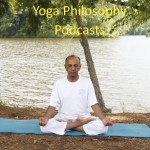
/
RSS Feed
I am pleased to present an audio recording of the monthly workshop on the Yoga Sutras of Patanjali held on Saturday, 11/16/19.
Brief summary of what we covered:
We continued the discussion of sutras in the early part of chapter 1. We discussed the concept of the five vrittis and also abhyasa (practice) and vairagya (detachment). We covered the following sutras:
- Sutra 1.7: pratyakṣa-anumāna-āgamāḥ pramāṇāni ॥7॥ The sources of right knowledge are direct perception, inference and scriptural testimony.
- Sutra 1.8: viparyayo mithyā-jñānam-atadrūpa pratiṣṭham ॥8॥ Misconception occurs when knowledge of something is not based upon its true form.
- Sutra 1.9: śabda-jñāna-anupātī vastu-śūnyo vikalpaḥ ॥9॥ An image that arises on hearing mere words without any reality [as it’s base] is verbal delusion.
- Sutra 1.10: abhāva pratyayālambanā vr̥ttirnidrā ॥10॥ That mental modification supported by cognition of nothingness is sleep.
- Sutra 1.11: anu-bhūta-viṣaya-asaṁpramoṣaḥ smr̥tiḥ ॥11॥ When a mental modification of an object previously experienced and not forgotten, comes back to consciousness, that is memory.
- Sutra 1.12: abhyāsa vairāgyābhyām tannirōdhaḥ ॥12॥ These mental modifications are restrained by practice and non-attachment.
- Sutra 1.13: tatra sthitau yatno-‘bhyāsaḥ ॥13॥ Of these two, effort toward steadiness of mind is practice.
- Sutra 1.14: sa tu dīrghakāla nairantarya satkāra-āsevito dr̥ḍhabhūmiḥ ॥14॥ Practice becomes firmly grounded when well attended to for a long time, without break and in all earnestness.
- Sutra 1.15: dr̥ṣṭa-anuśravika-viṣaya-vitr̥ṣṇasya vaśīkāra-saṁjṇā vairāgyam ॥15॥
The consciousness of self-mastery in one who is free from craving for objects seen or heard about is non-attachment. - Sutra 1.16: tatparaṁ puruṣa-khyāteḥ guṇa-vaitr̥ṣṇyam ॥16॥ When there is non-thirst for even the gunas (constituents of nature) due to the realization of Parusha (true Self), that is supreme non-attachment.
You can listen to the podcast as well as subscribe to it on itunes here.
Below are links to the powerpoint presentations used for these discussions:
- Yoga defined
- Ashtanga yoga (eight limbs)
- Kriya, Klesha, Karma
- Concept of Ishwara
- Dharana, dhyana, samadhi (samyama)
I would love to get your feedback.
Recent Comments